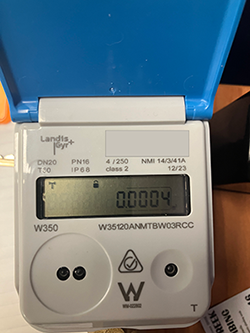
Home » Your water account » Your water meter » Reading your meter and checking for leaks
In This Section
Reading your meter and checking for leaks
Reading your Smart Meter

- Lift the lid to open.
- To turn on the screen, put your finger over the light sensor located on the bottom right-hand side of the meter. If it’s dark outside, you may need to shine a torch over the light sensor to turn it on and change screens.
- The first screen shows your total water use since we installed your meter. The reading is in cubic meters (1m3 = 1,000 litres), which is the same as kilolitres and can assist with checking if the read on your bill is correct. It's important to keep in mind that the meter reading on your bill may be different to your meter, depending on your billing cycle.
- You can scroll through the different screens to see different usage information such as cubic meters per hour, temperate and pressure. To change screens, put your finger on the light sensor located at the bottom right-hand side of the device for three seconds.
- The second screen shows water use in m3/h. If this screen is showing a number greater than zero, your taps are switched off and you're not using any water, you may have a leak.
- After about three minutes, the screen will return to the 'home screen' showing your total water use.
- You can return to the home screen at any point by closing the lid for three minutes before opening again.
Reading your meter - old style
A water meter measures the volume of water that passes through it. Every house has its own water meter, usually located in line with the front boundary of the property.
There are two types of water meters in use:
- Water meters that are manually read. The water meter reader physically sights the water meter reading.
- Water meters that are remotely read. The water meter has a cyble unit attached to the top that transmits the reading by radio frequency to the water meter reader’s hand-held reading device. These water meters can also be manually read.
To read your meter, record the numbers from left to right. The black numbers register kilolitres (a kilolitre is a thousand litres). Only this measurement is used to calculate your water usage. The red numbers register hundreds of litres, tens of litres, and litres. An example of the meter dials are shown below.
Reading of 830 kilolitres

Reading of 137 kilolitres

Checking for leaks
Leaks can occur in household water pipes, fittings and appliances. They are not always visible, so the best method of detection is to read your water meter regularly. If your consumption increases dramatically for no obvious reason, there could be a hidden leak.
To check for leaks:
- Turn off every tap in the house and check the reading of your water meter.
- Do not use any water (including the toilet) for at least one hour or overnight and check the meter before and after.
- If the reading has increased, without using any water in and around the house, you have a leak.
TIP: Check the toilet system by putting a drop of food colouring into the cistern. If the colour appears in the toilet bowl before flushing, you have a leak.
If you locate or suspect a leak, contact your plumber or contact us for assistance.